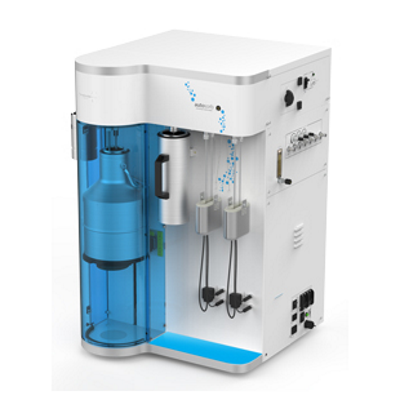
Features & Specifications & Upgrades
Autosorb-iQ-XR is automatic, high-vacuum, gas physisorption analyzer with 3 physisorption ports – each equipped for ultra-low pressure micropore analysis featuring a 0.1 torr pressure transducer. Physisorption mode features a dedicated saturation pressure (Po) transducer and a long-life dewar (LN2: >90 hours). Four built-in degas ports feature computer controlled ramp/hold/test protocols and dedicated cold-trap.
CryoSync was initially developed in response to the rising demand for argon analyses at liquid argon temperature (87.3 K). Compared to nitrogen, argon has no quadrupole moment. Therefore, argon molecules do not tend to orient or pack themselves in special ways in response to interactions with polar surface sites (ions, functional groups, etc.). This means that argon isotherms are insensitive to surface chemistry and sensitive only to surface physical and pore structural features.
However, this product is much more than a low-cost alternative to conventional cryostats. In fact, CryoSync users can perform longduration (>50 hours at 87.3 K) physisorption analyses at virtually constant temperatures (±0.005 K) in the range 82-115 K. Isotherms collected at multiple temperatures allow users to perform heats of adsorption calculations via the standard Clausius-Clapeyron method, in order to obtain additional information about the surface energetic heterogeneity of their samples.
CryoSync combines experimental advantages with advanced fundamental models (e.g., QSDFT kernels enabling hybrid combinations of pore geometries and independent analyses of metastable fluid-corrected adsorption branch vs. equilibrium desorption branch to ensure the most meaningful evaluation of pore structure network/percolation effects).
Vapor sorption: factory installed full vapor capability includes vapor source, pump ballast solenoid valve, and heated manifold (50°C). Typical vapors include water, alcohols, and aromatics.
General Analysis Specifications of Autosorb-iQ-XR
Adsorbates:
- N2, O2, Ar, Kr, CO2, CO, H2, NH3 or any other non-corrosive gas.
Sensitivity of pore volume (liquid):
- 1 x10-10 ml/g
P/Po Range
- <1 x 10-8 – 0.999.
Surface Area Range
- 0.01 m2/g to no known upper limit (nitrogen).
- 0.0005 m2/g to no known upper limit (krypton).
Operating modes:
- Classical helium void volume or (patented) helium-free mode. Re-measure void volume (after micropore range) feature.
Dosing methods:
- Wide variety, including pressure (classical target P/Po), Volume (VectorDoseTM), Maximum Increment, Time and Template (DoseWizardTM).
- Physisorption kinetics
Pore Size Range
- 5 to 5000 Å / 0.35 to 500 nm.
Sample Cell Specifications
Sizes:
- Available in different sizes for powders, pellets, granules and monoliths.
Stem internal diameters:
- 4 mm (6 mm o.d.), 7 mm (9 mm o.d.), 10 mm (12 mm o.d.).
Preparation (Degassing) Specifications
Four vacuum degassing stations supported by two heating mantles with over-temperature correction, individual tethering support system, and multi-step PC programmable ramp/hold/test protocols, for degassing up to a total of four sample cells. All degas ports are served by the dry turbo vacuum system, and a dedicated cold trap.
Ultimate Vacuum:
- 5×10-10 mbar (5 x 10-8 Pa) (3.75 x 10-10 mm Hg) achieved by turbo-molecular drag pump, 90 000 rpm, connected in series with an oil-free diaphragm pump.
Temperature Range:
- Ambient to 350°C
Temperature Programming:
- Via PC, including multiple ramps, holds and test protocols.
Temperature Fluctuation:
- < 5°C.
Temperature Accuracy:
- ± 1% of set point at thermocouple.
Degas Monitor:
- Pirani vacuum gauge.
Backfill Gas:
- Dedicated input port (He)
Data Analysis
Isotherms:
- Thousands of data points (per station), adsorption and /or desorption
- Hysteresis scanning – hysteresis in physisorption isotherms can be “scanned”, that is multiple ad/desorption cycles over desired P/Po ranges can be programmed.
Surface area:
- BET, Langmuir, STSA, BJH, DH, DFT; BET areas for materials with micropores
Micropores:
- NLDFT, QSDFT, Monte-Carlo, t-plot, alpha-s method, MP method, DR & DA methods, HK & SF methods.
Mesopores:
- BJH & DH methods (mesopores only), NLDFT & QSDFT methods (both mesopores and micropores).
Other:
- Total pore volume and average pore size.


